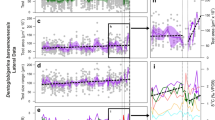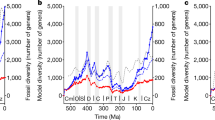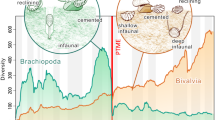Abstract
Two contrasting ecological models have been proposed for recovery from mass extinctions. The first posits that evolutionary recoveries are structured by trophic interactions alone, resulting in a predictable recovery of species richness and abundance earlier in lower trophic levels1. The second, the contingent model, holds that both chance and ecology are key to the structure of recoveries2, thus precluding inherent predictability. Documented recovery patterns from the Cretaceous–Palaeogene mass extinction could support either model1,3,4,5, as most previous studies have lacked the high-resolution records needed to discriminate between the scenarios. Here we use high-resolution marine sediment records to reconstruct pelagic community structure during the Palaeogene recovery in three sites in the South Atlantic and North Pacific Ocean. We document heterogeneity in the timing of recovery between sites from the alternative community structures characteristic in early pelagic ecosystems. We show that the evolution of species richness and abundance is decoupled between two well-represented groups of phytoplankton and zooplankton, as well as between taxa within a single trophic level. Our results favour the contingent recovery model. We suggest that ecological and environmental mechanisms may account for any similarities in community structure among sites and for the eventual transition from early recovery to late recovery communities, whereas chance may explain intersite differences in the timing and recovery path.
This is a preview of subscription content, access via your institution
Access options
Subscribe to this journal
Receive 12 print issues and online access
$259.00 per year
only $21.58 per issue
Buy this article
- Purchase on Springer Link
- Instant access to full article PDF
Prices may be subject to local taxes which are calculated during checkout



Similar content being viewed by others
References
Sole, R. V., Montoya, J. M. & Erwin, D. H. Recovery after mass extinction: evolutionary assembly in large-scale biosphere dynamics. Phil. Trans. R. Soc. Lond. B 357, 697–707 (2002).
Yedid, G., Ofria, C. A. & Lenski, R. E. Selective press extinctions, but not random pulse extinction cause delayed ecological recovery in communities of digital organisms. Am. Nat. 173, 139–154 (2009).
Coxall, H. K., D’Hondt, S. & Zachos, J. C. Pelagic evolution and environmental recovery after the Cretaceous–Paleogene mass extinction. Geology 34, 297–300 (2006).
Johnson, K. R. & Ellis, B. A tropical rainforest in Colorado 1.4 million years after the Cretaceous–Tertiary boundary. Science 296, 2379–2383 (2002).
Wilf, P., Labandeira, C. C., Johnson, K. R. & Ellis, B. Decoupled plant and insect diversity after the end-Cretaceous extinction. Science 313, 1112–1115 (2006).
Zachos, J. C., Arthur, M. A. & Dean, W. E. Geochemical evidence for suppression of pelagic marine productivity at the Cretaceous/Tertiary boundary. Nature 337, 61–64 (1989).
D’Hondt, S. Consequences of the Cretaceous/Paleogene mass extinction for marine ecosystems. Annu. Rev. Ecol. Evol. Syst. 36, 295–317 (2005).
Fuqua, L. M., Bralower, T. J., Arthur, M. A. & Patzkowsky, M. E. Evolution of calcareous nannoplankton and the recovery of marine food webs after the Cretaceous–Paleocene mass extinction. Palaios 23, 185–194 (2008).
Sole, R. V., Saldana, J., Montoya, J. M. & Erwin, D. H. Simple model of recovery dynamics after mass extinction. J. Theor. Biol. 267, 193–200 (2010).
Jiang, S. J., Bralower, T. J., Patzkowsky, M. E., Kump, L. R. & Schueth, J. D. Geographic controls on nannoplankton extinction across the Cretaceous/Palaeogene boundary. Nature Geosci. 3, 280–285 (2010).
D’Hondt, S. & Keller, G. Some patterns of planktic foraminiferal assemblage turnover at the Cretaceous Tertiary boundary. Mar. Micropaleontol. 17, 77–118 (1991).
Keller, G. & Pardo, A. Disaster opportunists Guembelitrinidae: Index for environmental catastrophes. Mar. Micropaleontol. 53, 83–116 (2004).
Olsson, R. K. in Atlas of Paleocene Planktonic Foraminifera (eds Olsson, R. K., Hemleben, C., Berggren, W. A. & Huber, B. T.) (SmithsonianInstitution, 1999).
Bown, P. Selective calcareous nannoplankton survivorship at the Cretaceous–Tertiary boundary. Geology 33, 653–656 (2005).
Alegret, L. & Thomas, E. Food supply to the seafloor in the Pacific Ocean after the Cretaceous/Paleogene boundary event. Mar. Micropaleontol. 73, 105–116 (2009).
Zachos, J. C. & Arthur, M. A. Paleoceanography of the Cretaceous/Tertiary Boundary event: Inferences from stable isotopic and other data. Paleoceanography 1, 5–26 (1986).
Bralower, T. et al. Grain size of Cretaceous–Paleogene boundary sediments from Chicxulub to the open ocean: Implications for interpretation of the mass extinction event. Geology 38, 199–202 (2010).
Broecker, W. S. & Clark, E. CaCO3 size distribution: A paleocarbonate ion proxy? Paleoceanography 14, 596–604 (1999).
Beer, C. J., Schiebel, R. & Wilson, P. A. Technical Note: On methodologies for determining the size-normalised weight of planktic foraminifera. Biogeosciences 7, 2193–2198 (2010).
Thierstein, H. R. Terminal Cretaceous plankton extinctions: A critical assessment. Spec. Pap. Geol. Soc. Am. 190, 385–399 (1982).
Dymond, J., Suess, E. & Lyle, M. Barium in deep-sea sediment: A geochemical proxy for paleoproductivity. Paleoceanography 7, 163–181 (1992).
Hull, P. M. & Norris, R. D. Diverse patterns of ocean export productivity change across the Cretaceous–Paleogene boundary: New insights from biogenic barium. Paleoceanography 26, 1–10 (2011).
Sepulveda, J., Wendler, J. E., Summons, R. E. & Hinrichs, K. U. Rapid resurgence of marine productivity after the Cretaceous–Paleogene mass extinction. Science 326, 129–132 (2009).
Hollis, C. J., Rodgers, K. A. & Parker, R. J. Siliceous plankton bloom in the earliest Tertiary of Marlborough, New-Zealand. Geology 23, 835–838 (1995).
Lichtman, E. in Evolution of Primary Producers in the Sea (eds Falkowski, P. G. & Knoll, A. H.) 351–375 (Elsevier, 2007).
Alegret, L. & Thomas, E. Deep-sea environments across the Cretaceous/Paleogene boundary in the eastern South Atlantic Ocean (ODP leg 208, Walvis Ridge). Mar. Micropaleontol. 64, 1–17 (2007).
Gerstel, J., Thunell, R. & Ehrlich, R. Danian faunal succession—planktonic foraminiferal response to a changing marine-environment. Geology 15, 665–668 (1987).
D’Hondt, S., Donaghay, P., Zachos, J. C., Luttenberg, D. & Lindinger, M. Organic carbon fluxes and ecological recovery from the Cretaceous–Tertiary mass extinction. Science 282, 276–279 (1998).
Westerhold, T. et al. Astronomical calibration of the Paleocene time. Palaeogeogr. Palaeoclimatol. Palaeoecol. 257, 377–403 (2008).
Zachos, J. C. et al. Site 1262, Proc. ODP, Init. Repts., 208 (Ocean Drilling Program, 2004).
Acknowledgements
This work was funded by NASA Exobiology grant NNX07AK62G (to R.D.N. and T.J.B.) and supported by the Ocean Drilling Program (special thanks to P. Rumford, C. Broyles and J. Firth). Thanks to A. Bhattacharya at Harvard for helium data, discussions and manuscript comments; S. Jiang at Jinan University for nannoplankton data; L. Eccles, T. Lindemann and G. Smith at Penn State for size structure analyses; D. Andreasen at UC Santa Cruz for stable isotope analyses; S. Kirtland, T. Westerhold and U. Röhl for X-ray fluorescence core scanning at the Bremen Repository; J. C. Zachos at UC Santa Cruz for suggesting the shell-weight analyses; M. D. Ohman and the Norris lab (Scripps Inst. of Oceanography), the Briggs lab (Yale), and M. L. Spreitzer, T. Manousaki and S. Fan (Universität Konstanz) for comments and suggestions improving the clarity of the manuscript.
Author information
Authors and Affiliations
Contributions
P.M.H., R.D.N. and T.J.B. conceived the study; all authors generated, compiled and analysed the data, and contributed to the writing of the manuscript.
Corresponding author
Ethics declarations
Competing interests
The authors declare no competing financial interests.
Supplementary information
Supplementary Information
Supplementary Information (PDF 7082 kb)
Rights and permissions
About this article
Cite this article
Hull, P., Norris, R., Bralower, T. et al. A role for chance in marine recovery from the end-Cretaceous extinction. Nature Geosci 4, 856–860 (2011). https://doi.org/10.1038/ngeo1302
Received:
Accepted:
Published:
Issue Date:
DOI: https://doi.org/10.1038/ngeo1302
This article is cited by
-
The Chicxulub impact and its environmental consequences
Nature Reviews Earth & Environment (2022)
-
Rapid recovery of life at ground zero of the end-Cretaceous mass extinction
Nature (2018)
-
A probabilistic assessment of the rapidity of PETM onset
Nature Communications (2017)
-
Mercury anomalies and the timing of biotic recovery following the end-Triassic mass extinction
Nature Communications (2016)
-
The end-Cretaceous in the southwestern Tethys (Elles, Tunisia): orbital calibration of paleoenvironmental events before the mass extinction
International Journal of Earth Sciences (2016)



